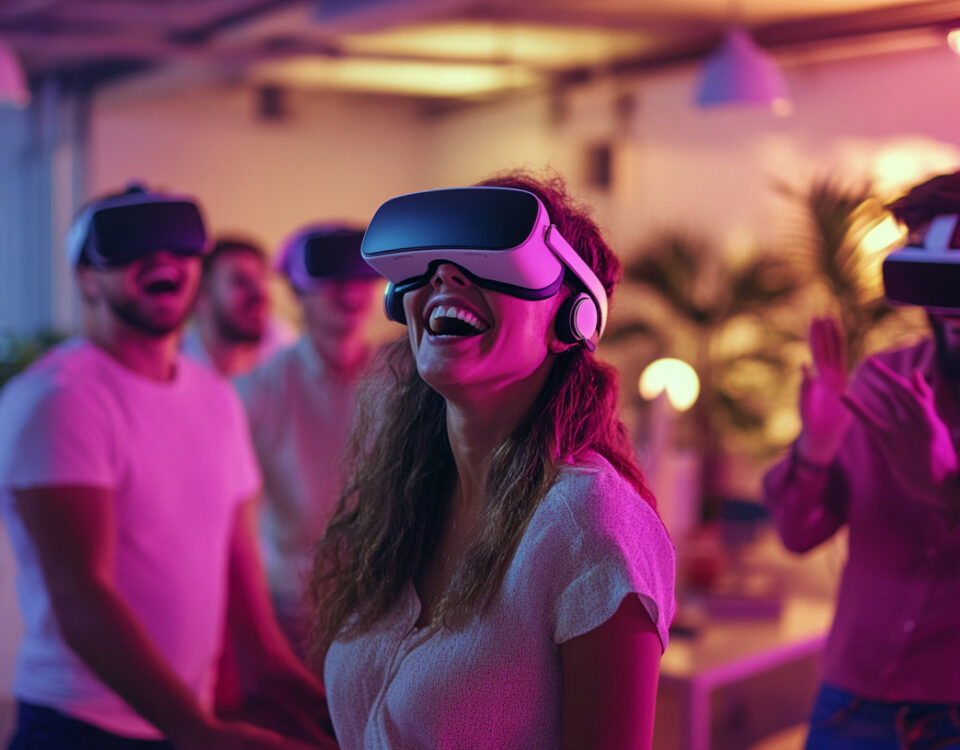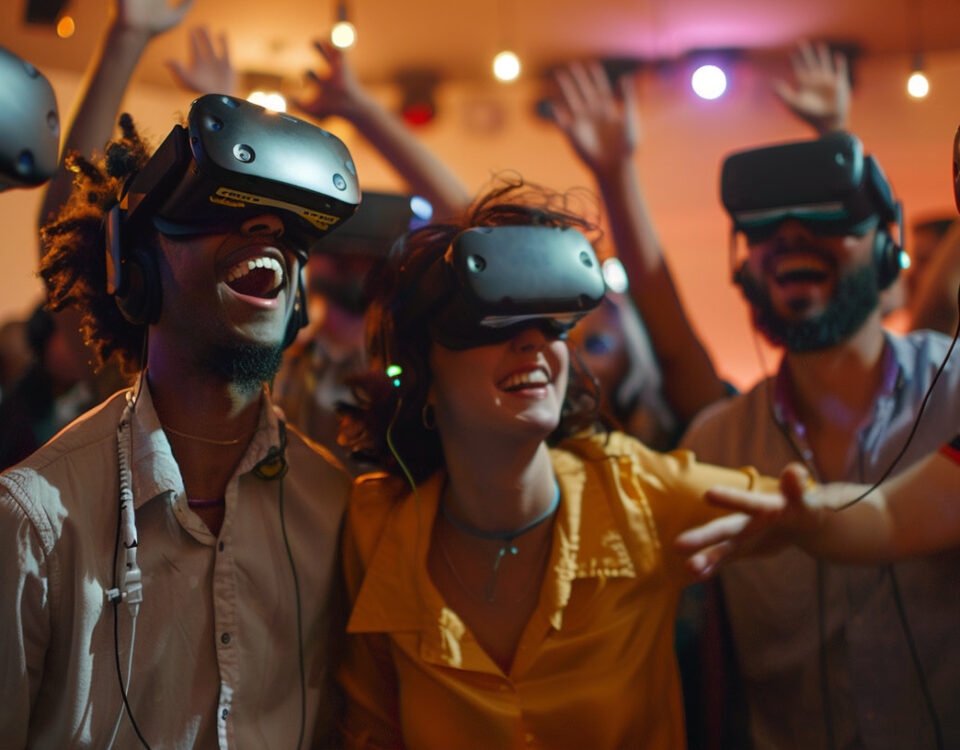
Top 5 Virtual Reality Rentals for Corporate Events in Utah
March 10, 2025Virtual Reality vs Augmented Reality (VR and AR) are no longer just sci-fi fantasies—they're reshaping how we interact with the world, from gaming and healthcare to remote work and education. But what if the line between reality and simulation isn't as clear as we think? Some theorists argue that VR could one day become indistinguishable from the physical world, blurring the boundaries of perception. With the global extended reality (XR) market projected to surpass $100 billion by 2026, it's clear these technologies aren't just passing trends. Whether it's Apple's Vision Pro headset or AR-powered remote support tools, the race to dominate this space is heating up—but which one truly holds the key to the future?
While VR immerses you in a fully digital universe, AR enhances your real-world surroundings with digital overlays, creating two distinct yet equally transformative experiences. Imagine surgeons practicing in a risk-free VR simulation or retail shoppers trying on clothes virtually with AR—these aren't distant dreams but today's realities. Yet, despite their shared potential, AR and VR serve vastly different purposes. AR thrives in practical applications like industrial maintenance and navigation, while VR dominates gaming and immersive training. As industries scramble to adopt these technologies, understanding their differences isn't just academic—it's essential for unlocking their full potential. So, which one will redefine your world first?
What is VR?
So, what is VR? Picture putting on a headset and suddenly being inside a video game—that's virtual reality for you. It's not just about seeing a screen; it's about stepping into a whole new world, one where the real one fades away completely. VR vs AR debates often highlight this key difference: VR replaces reality, while AR adds to it. The tech behind this? Headsets like the Meta Quest 3 (2023) or Valve Index track your every move, making the virtual space react to you in real-time. Think of it like being locked in a dream you can control—except the dream's made of pixels and code. The goal? Total immersion. You're not just watching; you're there, whether you're climbing Everest or battling aliens.
But VR isn't just games. Surgeons use it for training; architects walk clients through unbuilt homes. It's a tool, a playground, even a therapy device—all wrapped in a headset. Now, imagine taking that headset off and seeing the real world again… but with digital layers on top. That's where AR comes in.
What Is AR?
So, what is AR? Well, augmented reality—or AR—isn't just some futuristic gimmick; it's a tech that layers digital stuff—images, sounds, even videos—right onto the real world around you, and it happens in real-time (think Snapchat filters or Pokémon Go). Unlike VR, which plops you into a totally fake environment, AR enhances what's already there; it's like having a HUD for life, giving you extra context without yanking you out of reality. The whole point? To make your interactions with the physical world richer—whether that's seeing how a sofa looks in your living room before buying it (thanks, IKEA Place) or getting live translations of street signs through your phone's camera.
When comparing AR vs VR, the key thing is integration: AR blends virtual elements with the real world, while VR replaces it entirely. And this isn't just theory—by 2023, over 1.4 billion people were using AR regularly, mostly through mobile apps, because it's accessible; no fancy headsets needed, just your phone. But here's the kicker—AR's not just for games or shopping. Surgeons use it to overlay patient data during operations; mechanics pull up repair guides mid-job; even museums slap digital exhibits right over ancient artifacts.
Now, with both AR and VR making waves, how do they actually stack up side by side?
What's the Difference Between the Two?
So what's the difference between the two? Well, augmented reality vs virtual reality comes down to how they mess with your perception—AR layers digital stuff onto the real world (think Pokémon Go), while VR yanks you out of reality entirely with a headset. Here's the breakdown:
(1) VR's all about immersion, blocking out everything real; AR just tweaks what you already see.
(2) Hardware-wise, VR needs bulky goggles; AR can run on smartphones or smart glasses.
(3) VR's got a steeper learning curve—you're basically blind to the real world—whereas AR lets you multitask.
(4) Use cases differ wildly: VR dominates gaming and training sims (like pilots practising emergencies), while AR shines in retail or navigation (Ikea's app lets you preview furniture in your room).
The lines blur sometimes—mixed reality headsets like Microsoft's HoloLens try to do both—but the core split's clear.
Real-World Applications of VR and AR
Virtual reality and augmented reality aren't just sci-fi fantasies anymore—they're reshaping industries right under our noses. Take AR, for instance: it's revolutionizing fields like manufacturing, where technicians use it to troubleshoot equipment hands-free, slashing downtime by up to 30% (2023 data). Meanwhile, VR's immersive power is transforming training; Walmart rolled out VR modules for 1 million employees, cutting onboarding time in half. The line between augmented reality and virtual reality blurs in healthcare, though—surgeons practice on VR simulations, while AR overlays patient vitals during operations.
These technologies aren't just flashy gimmicks; they're solving real problems. AR's industrial applications, like Boeing's wiring assembly guides, reduced errors by 90%, while VR's role in mental health (like Oxford VR's social anxiety therapy) shows its softer side. The key difference? AR enhances reality; VR replaces it—but both are rewriting playbooks.
The Future of These Technologies: Trends to Watch
The data's clear: AR and VR are speeding toward mainstream adoption, with 2023 seeing a 40% jump in hardware sales (IDC, Q2 2023). Education's leading the charge; universities like Stanford are already running full VR lectures, and companies are dumping cash into AR training sims. Bandwidth upgrades and sharper displays are killing the "laggy, pixelated" rep these techs used to have—now it's less "glitchy mess" and more "how did we ever work without this?" The vr vs ar debate? It's not winner-takes-all; they're merging, like AR overlays in VR meetings (looking at you, Meta).
TIP: Don't bet on one horse—ar vs vr is a false binary. Watch for hybrid tools (think Apple's Vision Pro) blending both; that's where the real money's headed.
Conclusion
Virtual reality and augmented reality are like two sides of the same dazzling coin, each offering its own unique magic. VR whisks us away to entirely new worlds, letting us escape reality, while AR sprinkles digital wonders onto the world we already know. Both are reshaping how we learn, work, and play, proving that the line between the real and the virtual is blurrier than ever.
As we step into the future, these technologies will keep evolving, bending the rules of what's possible. So buckle up, whether you're diving into VR or layering AR onto life, the adventure's just beginning!



